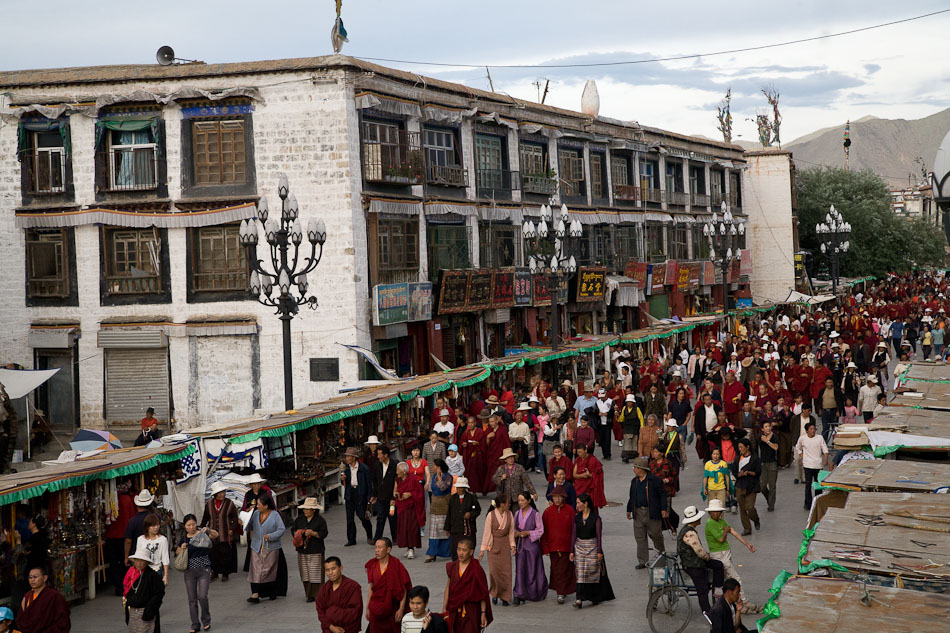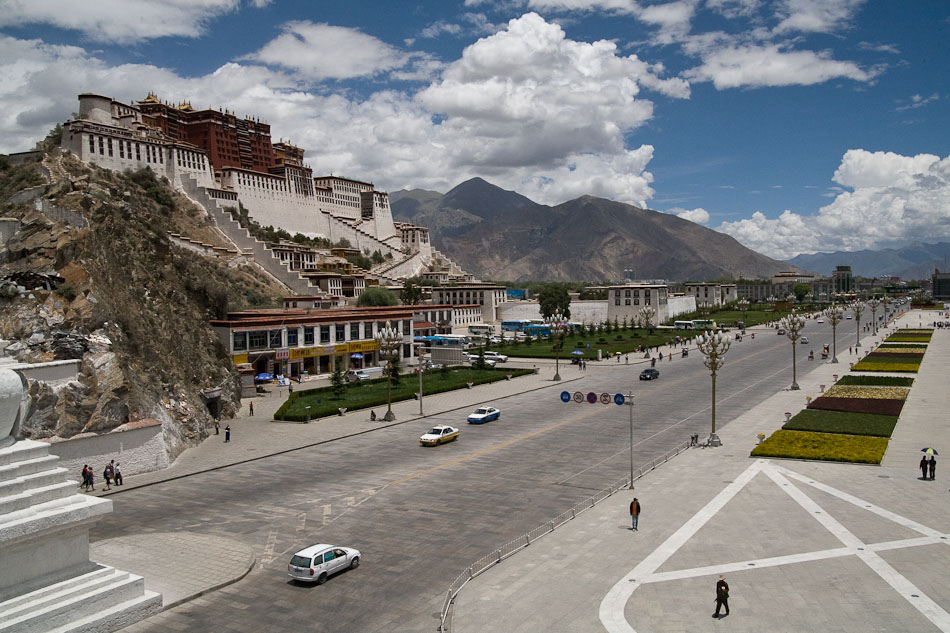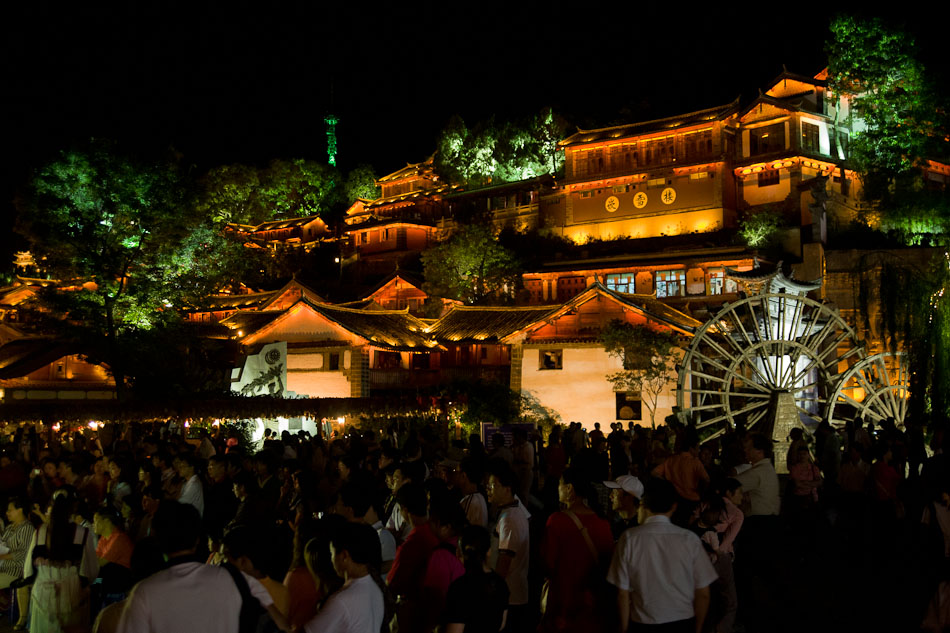Jul 4, 2007 | Travel

As the cultural center and capital of Tibet, Lhasa constantly remains poised to set the socioeconomic tone for the rest of the region. However, after a third visit over six years, characterizing that tone continues to evade me. Lhasa’s elusive nature never seems to resolve itself as the colorful Tibetan quarter continues to hold out against the encroaching conurbations inhabited by immigrating Han Chinese. Two years ago such architecturally uninspiring edifices seemed poised to swallow old Lhasa whole, but now I feel quite the opposite.
The Barkhor pilgrim circuit encompassing the Jokhang temple at the heart of the Tibetan quarter emitted a vivacity I had never felt before. On a daily basis thousands of pilgrims, monks, nuns, and awkward tourists rambled around the residence of the most revered Buddha image in Tibet. An odd cacophony emerged from the crowd as the murmur of prayers mixed with shuffling feet, congenial conversations, and the occasional resounding smack of pilgrims clapping their hands above their heads before prostrating on the ground. More importantly, the alleys surrounding the Barkhor teemed with Tibetans perusing small local markets and bustling about their daily business. I felt I had slipped into a vibrant Tibetan city instead of a fading relic of the past.

Since Tibet’s “peaceful liberation,” the Chinese state has largely committed itself to implementing “progressive” socioeconomic policies in Lhasa in hopes of bringing the rest of the region under more centralized control. Many indigenous customs were condemned while major religious institutions endured heavy censure and sometimes destruction in an attempt to redefine their identities and role in communities. For example, since the fourteenth Dali Lama’s 1959 exile into India, the Potala Palace was transformed into a state museum used to portray his presence as a figment of the past overcome by the ineluctable advent of modernity. Monks that attended the shrines were not even allowed to wear traditional monastic robes – the Chinese state did not want any indication that it still remained a functioning religious institution. Within the scope of socioeconomic progress, the Chinese state attempted to consign the Potala Palace to a bygone epoch just like the Forbidden City in Beijing. Still, its potency and ability to inspire awe remained, just as an undeniable resilience still prevailed within the Tibetan quarter.
Lhasa embodies an odd paradox posed by free market reforms and the rise of consumer culture introduced by the Chinese state. Newly built strip malls now crowd important temples and monasteries – centers of a faith devoted to self-abnegation and rarified spiritual pursuits. Nonetheless, a monk pulling a slick cell phone from beneath his robe no longer seems so strange a sight. Many religious institutions subsist on a very ambiguous line as mere tourist attractions and functioning monastic and spiritual centers. In all, generalizations continue to fail to capture this marvelous city as it persistently twists into a stranger synthesis of global influences and longstanding traditions.
Jun 26, 2007 | Society, Travel

Six years ago I stepped off the bus in Dali, a provincial town five hours outside of Kunming. An appealingly antiquated road lined with curious shops and small guesthouses stretched out before me. For years backpackers were drawn to Dali’s laidback feel and the welcoming climes of the province in general. I was drawn to the possibility of eating a decent stack of pancakes at one of the cafes flaunting their newfound western culinary expertise. Although I only stayed for two days, the place stuck with me over the years and I looked forward to my eventual return.
Six days ago I stepped off the bus in Dali, what is now a major stopover on Yunnan Province’s tourist circuit stretching from Kunming to Zhongdian. The quiet lane fit for afternoon strolls had completely disappeared beneath a cobblestone pedestrian mall lined with indistinguishable storefronts and punctured by lurid guard towers fashioned after medieval counterparts found elsewhere in China. The town had undergone massive cosmetic surgery – bordering on a complete sex change. Decent stacks of pancakes still abounded but little else shown threw this once charming town.
China’s burgeoning middleclass and their surplus wealth has led to an unprecedented domestic tourism boom throughout the country. Unfortunately, such demand tends to overwhelm and eventually reshape the architecture and surrounding landscape wherever it manifests. Many areas of Yunnan Province have been particularly susceptible to the lure of such a cash heavy industry and Dali fell in quick succession. Its high concentration of tribal cultures, officially designated as “ethnic minorities” by state legislation, easily became an exotic and alluring foil for the rest of China.
Despite the growth of these tourist rackets that seek to cater to ever broader and more lavish tastes, such leisurely devices cannot be completely dismissed considering the vagaries suffered by many of these same people over the last fifty years. A wizened old couple wandering wide-eyed through the streets of Dali approached me to take a snapshot with them (group photographs with random foreigners are still a highly prized memento for many Chinese vacationers). I talked briefly with them but will never forget the startling strength of the old man’s grip when I shook his hand to depart. His slender, sinewy arm concealed a lifetime of toil in tiered fields and this trip represented one of his first leisurely respites to a tourist destination – something I too often take for granted. It’s hard to deny him such an experience even if I felt he was wandering around a farcical tourist trap.
Trying to repress nostalgic whims for untrammeled locales does not come easily in my travels, even while observing the enjoyment that many Chinese tourists take in these cultural theme parks. A disconcerting tendency still emerges as these destinations become washed out due to the massive influx of clamoring sightseers and their desirous gazes. Lijiang, the next town on the Yunnan Province tourist circuit, is probably the worst case. Its once mesmerizing downtown dominated by winding streets crisscrossed with bubbling streams are now subject to an enforced lighting scheme. The area resembled a movie set and massive buses spat out an illimitable flow of bobbing heads led by tour guides with megaphones and company pennants. Although I still found some peace and quiet on the fringes of the chaos, I still secretly indulged my wish for this tide to ebb.


